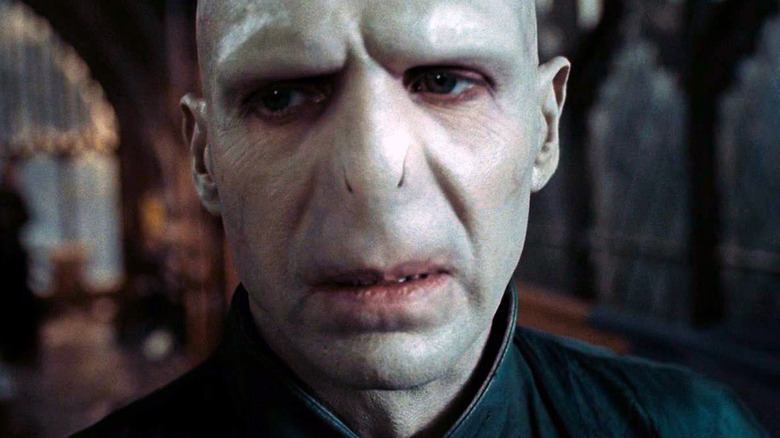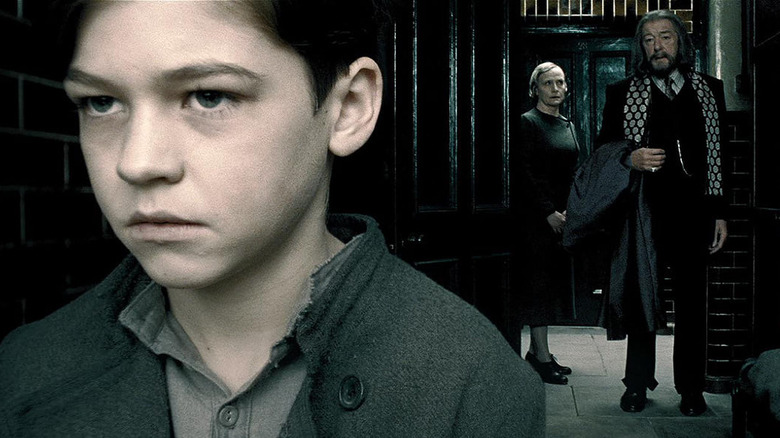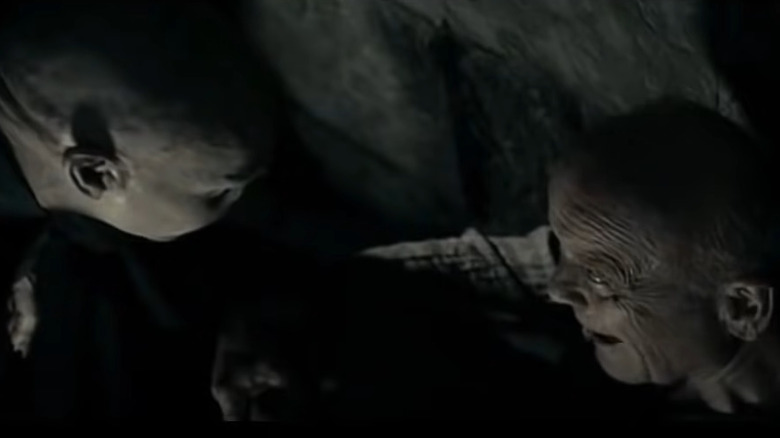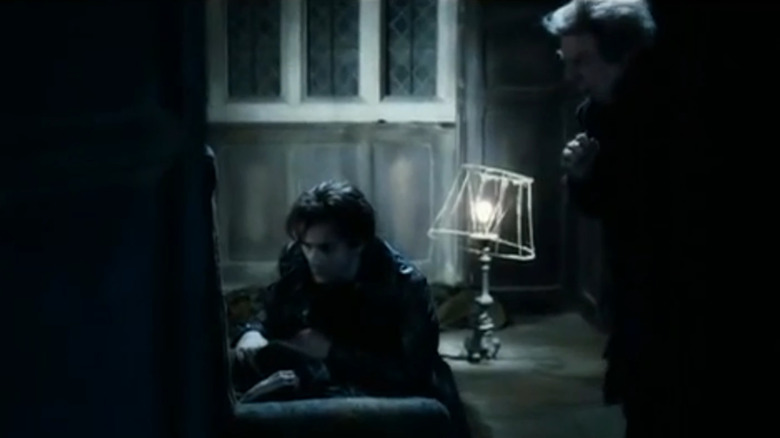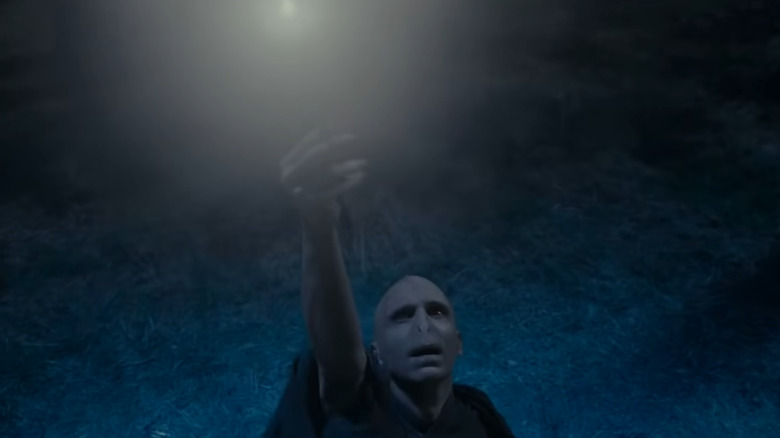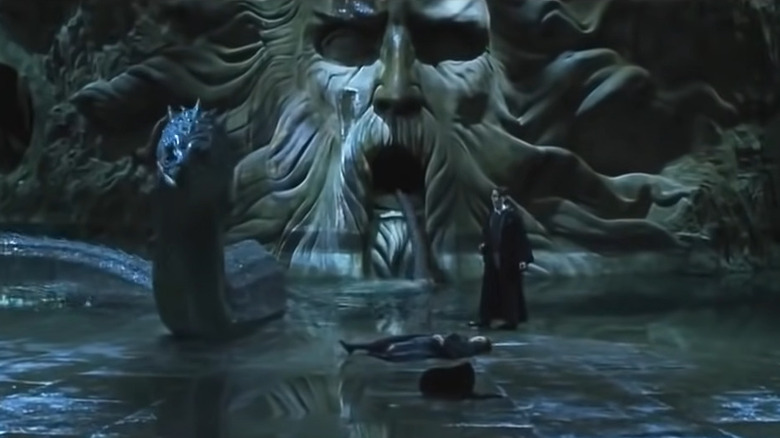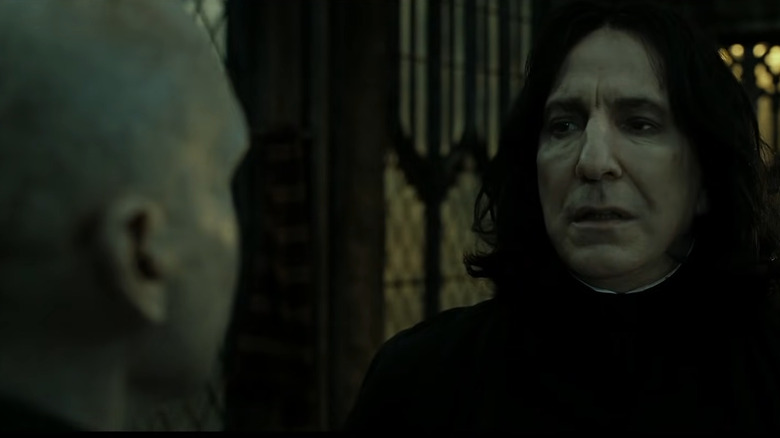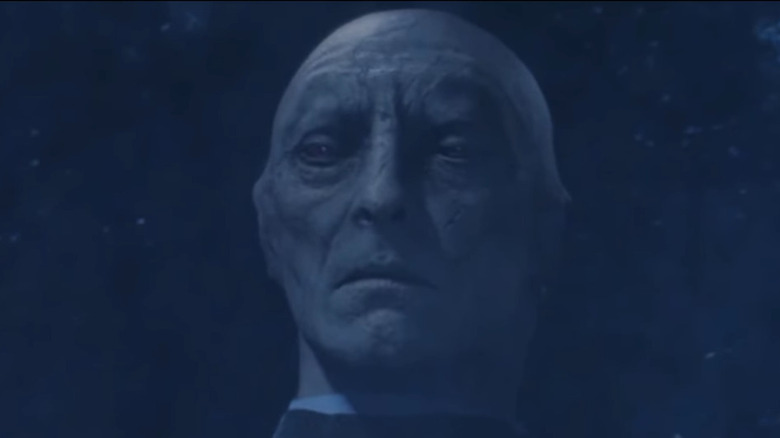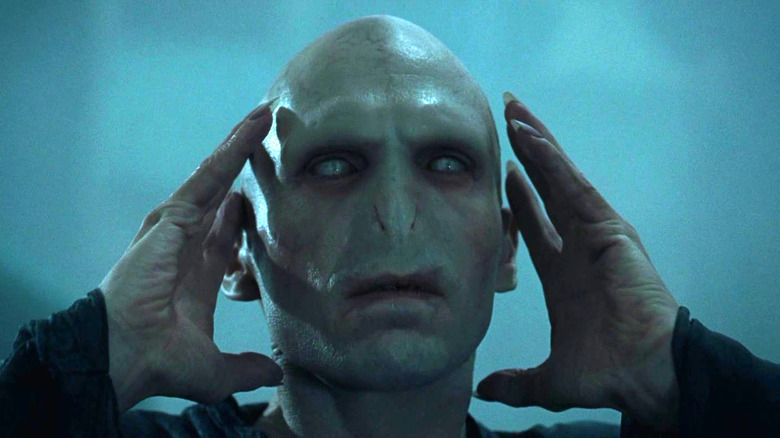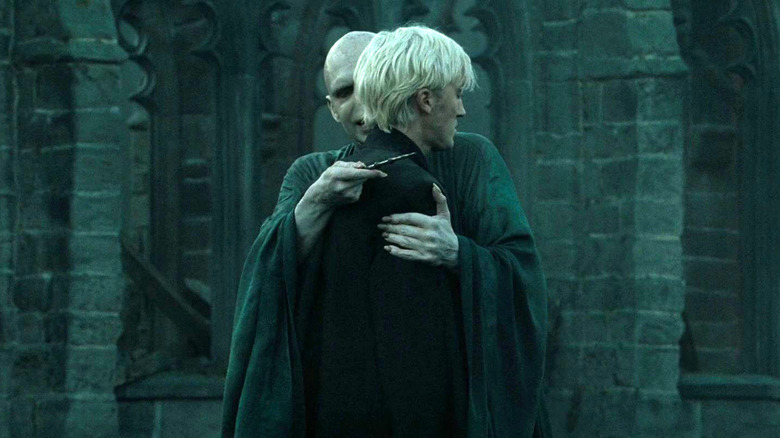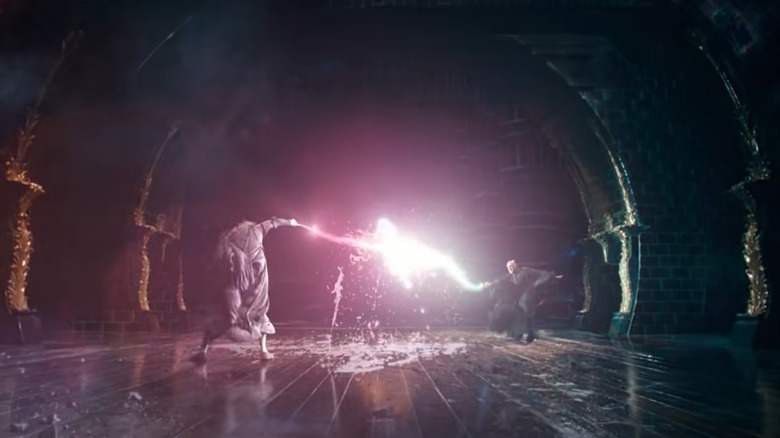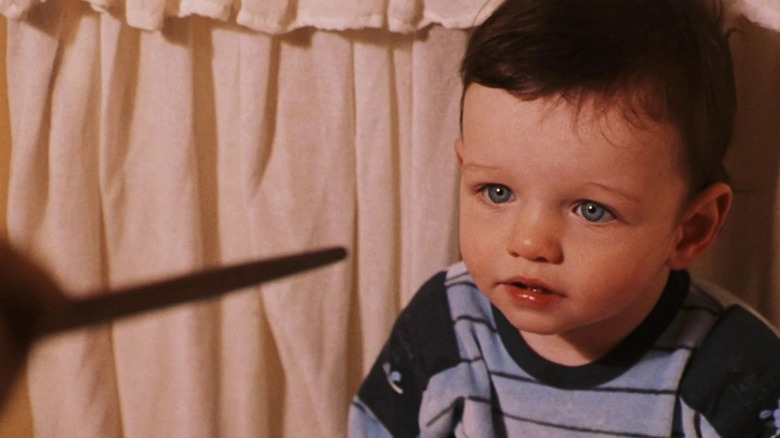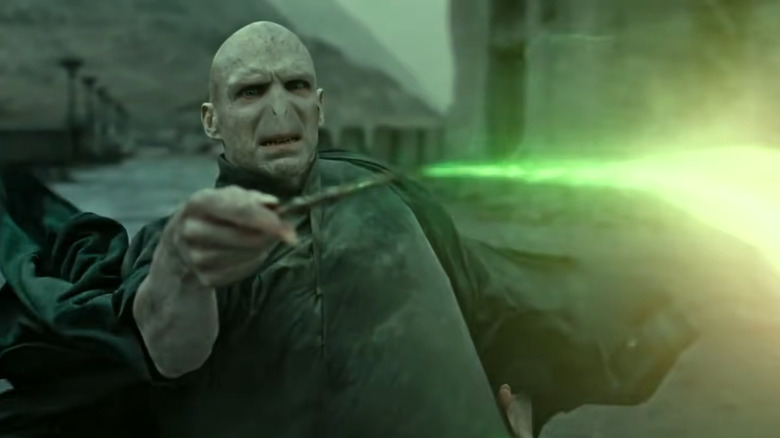Voldemort's 12 Most Memorable Scenes From The Harry Potter Franchise
He Who Must Not Be Named. Tom Marvolo Riddle. The Dark Lord. Voldemort. Whatever you call him, the big bad of the "Harry Potter" franchise is one of the most menacing villains in movie history. Brought to life primarily by Ralph Fiennes, Voldemort is particularly distinguished by his mutable nature. He could be anywhere, hiding in places as disparate as the back of someone's head or an old diary. Moreover, thanks to his mastery of dark magic, he is very nearly immortal.
No matter what form he's in, an encounter with Lord Voldemort is guaranteed to be terrifying. It's not for nothing that most of wizardkind is afraid to even speak his name. Sinister, sneaky, and Slytherin through and through, Voldemort is one bad dude — and we're here to take a closer look at the moments that make this abundantly clear. These are Voldemort's 12 most memorable scenes from the "Harry Potter" franchise.
12. Meeting Dumbledore
During "Harry Potter and the Half-Blood Prince," Harry and Dumbledore spend a great deal of time procuring memories from those who knew Voldemort during his youth and childhood, when he was still known as Tom Riddle. Using a magical device called a Pensieve, Dumbledore and Harry enter these memories and observe them firsthand, in the hopes of finding useful information that may lead to Voldemort's defeat.
One such memory comes from Dumbledore himself. In this recollection, Dumbledore visits young Tom Riddle in the orphanage he calls home, and informs him of his wizarding identity. It's interesting to contrast this scene with the moment Hagrid tells Harry he's a wizard. Both Voldemort and Harry grow up ignorant of their magical abilities, but inherently suspect they're somehow different. Harry is gleeful (if a bit skeptical) upon hearing the news that he's a wizard, while Tom, who is more subdued, immediately connects it to cruelty. "I can make bad things happen to people who are mean to me," he tells Dumbledore. "I can make them hurt, if I want." Dumbledore is visibly concerned, and while he's far too kind to assume the worst of a child, he's clearly distraught about this boy's future. All the same, he extends Tom an invitation to attend Hogwarts. Thus, Voldemort's wizarding career begins.
11. Voldemort confronts Grindelwald
In "Harry Potter and the Deathly Hallows — Part 1," Voldemort's travels lead him to elderly Gellert Grindelwald's prison cell. This quick scene contains the first and only appearance of Grindelwald in the main "Harry Potter" film series. While this movie barely touches upon Grindelwald's identity, fans of the books know that Grindelwald has a history with Dumbledore, and that he was the most evil wizard of his generation.
It wasn't until the "Fantastic Beasts" prequel series debuted that viewers gained a full understanding of who Grindelwald is. As the primary antagonist, he gets much more screen time than he does in "Harry Potter" proper, which is used to delve into his motivations and romantic past with Dumbledore. Grindelwald's place in the "Fantastic Beasts" movies gives his brief scene in "Deathly Hallows — Part 1" much more significance than it had upon initial release. Back then, Grindelwald was a random character. Now, the audience understands the gravity of this meeting. Two of the Wizarding World's most nefarious forces come face to face for the first and only time here. When it's all said and done, Grindelwald gives Voldemort what he seeks: knowledge of the Elder Wand's hiding place.
10. The Riddle house
At the beginning of "Harry Potter and the Goblet of Fire," Voldemort is gaining strength, but remains very weak. Though he exists in a physical form, he has yet to inhabit his full-grown body. We only get glimpses of his current state, but they're vivid: His small, skeletal arm hangs limply over an armrest, and his voice is scraggly and scratchy. Voldemort meets with two longtime accomplices, Wormtail and Barty Crouch Jr., in an abandoned house that once belonged to his father and paternal grandparents. It's still known to the surrounding Muggle community as "the Riddle house," though the Riddles haven't lived there in decades.
Spying activity in the long-dormant house, a Muggle sneaks inside to investigate. It is, sadly, the last mistake he'll ever make. Voldemort's snake, Nagini, informs her master of the Muggle's presence in the house, and Voldemort promptly kills the man using the killing curse. This effectively communicates that while Voldemort might physically be a shadow of his dangerous former self, he's still capable of inflicting harm and is hungry to do so.
9. Stealing the Elder Wand
Legend has it that the Elder Wand is the most powerful wand in existence. Seeking an upper hand in his reign of terror, Voldemort spends the length of "Harry Potter and the Deathly Hallows — Part 1" tracking it down. He interrogates famous wandmakers like Ollivander and Gregorovitch, to no avail. Finally, the imprisoned Grindelwald gives the Dark Lord the information he wants. It turns out that the most recent owner of the Elder Wand was none other than Albus Dumbledore, and the Wand rests within his coffin.
Never one to mind disrespecting the dead, Voldemort unceremoniously breaks Dumbledore's grave open and pries the Elder Wand from the former Hogwarts headmaster's hands. Not only does this moment bring Voldemort's actions to a vile new level, it's the cliffhanger ending that concludes "Deathly Hallows — Part 1." Things have never looked as dark as they do the moment the Dark Lord lifts the fabled wand to the sky: Possessing it makes him, quite literally, the most powerful wizard in existence. The only person who might have bested him is lying in a shattered grave.
8. The truth about Tom Marvolo Riddle
Throughout "Harry Potter and the Chamber of Secrets," 12-year-old Harry communicates with a mysterious person named Tom Riddle by means of an old diary. At the film's climax, which takes place deep within the bowels of the Chamber of Secrets, Harry finds himself face-to-face with Riddle. But he soon discovers Tom isn't the friend he portrayed himself as. This ghostly teenage Hogwarts student is actually Voldemort: The letters of his full name, Tom Marvolo Riddle, are an anagram that can be rearranged to read "I am Lord Voldemort."
Four movies later in "Harry Potter and the Half-Blood Prince," the audience learns that Voldemort is functionally immortal through the use of horcruxes, magical items containing the shards of his shattered soul. But in "Chamber of Secrets," the reveal that Voldemort has been hiding in an old diary — and that he was once a handsome, talented Hogwarts student — is a major shock. Gaining knowledge about Voldemort's past and learning he's the fabled heir of Slytherin is enough to send chills up anyone's spine, and sets a grand backdrop for the battle between Harry and the basilisk.
7. Killing Snape
Voldemort's obsession with the Elder Wand becomes manic in the final installment of the series, "Harry Potter and the Deathly Hallows — Part 2." The Dark Lord isn't the Wand's rightful owner, as he soon realizes, which means he can't command its full power. He took the Wand from Dumbledore's grave, but by that point, the Wand's allegiance already belonged to another wizard. Voldemort assumes this wizard is Severus Snape, since Snape killed Dumbledore. Therefore, Snape must die. Voldemort approaches Snape in the Hogwarts boathouse. He quietly explains, "You've been a good and faithful servant, Severus, but only I can live forever." He then slits Snape's throat with a spell, and instructs his snake, Nagini, to finish the job.
This scene operates on multiple levels, which makes it fascinating to pick apart. First off, Voldemort is wrong on two accounts. As the audience soon learns, Snape has been on the good guys' side all along, convincingly acting as a double-agent while remaining loyal to Dumbledore. Voldemort doesn't realize this. Secondly, the Elder Wand's allegiance lies with Harry, not Snape. Snape may have killed Dumbledore, but Malfoy disarmed Dumbledore first. Then, at the end of "Deathly Hallows — Part 2," Harry disarmed Malfoy, making him the Wand's current master. Thus, when Voldemort kills Snape, he's at the apex of his hubris. It's one of his most brutal crimes, but also one of his most foolish mistakes.
6. The man with two faces
During Harry Potter's first year at Hogwarts School of Witchcraft and Wizardry, he works hard to catch up on the ins and outs of the Wizarding World. The knowledge he gains is often enigmatic, given his own bizarre past. Most mysterious of all, Harry discovers the truth about how his parents died at the hand of Lord Voldemort, the evil wizard who's been missing for years and many believe to be dead.
At the climax of "Harry Potter and the Sorcerer's Stone," Harry ventures deep within a secret passageway to retrieve the titular Sorcerer's Stone before a sinister someone can get their hands on it. Suspecting Professor Snape to be that mysterious villain, Harry instead finds Professor Quirrell. His timid disposition has been a façade this entire time. Quirrell removes his turban, revealing the face of Lord Voldemort on the back of his head. This scene marks Harry's first-ever face-off with Voldemort since his infancy, and the first time the audience gets a look at the iconic villain.
5. The Dark Lord reborn
Throughout the first three "Harry Potter" movies, the audience gets glimpses of Voldemort as his shattered soul manifests in various forms, including a face on the back of Quirrell's head and the ghost of Tom Riddle. It isn't until the ending of "Harry Potter and the Goblet of Fire" that the franchise gives viewers their first full look at Voldemort's true self. This chillingly intimate yet narratively grand introduction comes courtesy of a dark ritual performed by Wormtail, aka Peter Pettigrew, the man who betrayed Harry's parents.
Wormtail sets up a cauldron at Voldemort's father's grave. After unceremoniously dropping Voldemort's infant-sized body inside, Wormtail brews a dark potion from one of the elder Tom Riddle's bones, Wormtail's own hand, and a trickle of Harry's blood. Through these materials, Wormtail proclaims, Lord Voldemort will be restored. This is exactly what comes to pass. The audience sees Ralph Fiennes in full costume for the first time as the Dark Lord rises from the cauldron and revels in his revived flesh. From this point forward, the series shifts. Lord Voldemort is back in the Wizarding World.
4. Voldemort's victory hug
After successfully luring Harry into the Forbidden Forest in "Harry Potter and the Deathly Hallows — Part 2," Voldemort performs the infamous killing curse upon the Boy Who Lived. Instead of killing Harry, though, the spell merely destroys the scrap of Voldemort's soul that latched onto him when he was a baby, which inadvertently made Harry the Dark Lord's last horcrux.
Thinking he's won, Voldemort struts back to Hogwarts with Harry's limp body in tow. The audience, for a moment, gets a glimpse into a dark alternate universe where Voldemort wins. "Harry Potter is dead!" Voldemort shouts in triumph. Many principal characters, gathered in the Hogwarts courtyard, hear this awful declaration and see Harry's apparent corpse. But Neville Longbottom, uncowed by this cruelty, confronts the Dark Lord and gives a rousing speech worthy of his house.
This scene is memorable for that speech, but also in a way the filmmakers didn't intend. Voldemort calls for stragglers to join his cause, at which point Draco Malfoy steps forward and walks toward him. Voldemort embraces Malfoy, saying softly, "Oh, Draco, well done." The moment is likely intended to invoke fear and display Voldemort's menace, but watching Voldemort hug someone is so awkward, it's accidentally hilarious. Interestingly, actor Tom Felton, who plays Draco Malfoy, revealed in 2011 that the hug was not in the script.
3. The only one he ever feared
It's often noted that the only wizard Voldemort is afraid of is Albus Dumbledore. Towards the end of "Harry Potter and the Order of the Phoenix," fans finally get to witness an epic showdown between these two titans of magic. It's the only battle of its kind in the entire series, as a clash between two full-grown experts with vast reserves of wizarding knowledge. The stakes are high, and the reputations of both men precede them. If one doesn't have any knowledge of what happens next, nor how many volumes are in the "Harry Potter" saga, it could almost feel as if everything has been leading to this moment, and that the series might conclude after it ends. Of course, that's far from being the case, but the weight of the scene is undeniable.
Following a special effects tour de force in which both wizards display their might and skill, Voldemort infiltrates Harry's mind as a last resort. Kneeling beside his student, Dumbledore implores Harry to focus on the power he has in spades, and Voldemort lacks entirely: love. Harry keeps Voldemort at bay with memories of the people he cherishes, and sorrowfully declares that Voldemort will never know such bonds. Voldemort flees upon the arrival of Minister of Magic Cornelius Fudge, concluding one of the Dark Lord's most iconic moments in the series.
2. The night that started it all
Voldemort's hatred of Harry begins on an ordinary night. Following clues from a prophecy, the Dark Lord goes on the hunt for the child who possesses the potential to defeat him. After bombarding the Potters' home in the village of Godric's Hollow, Voldemort kills Harry's father, James. Fearing what might come next, Harry's mother, Lily, throws herself in front of baby Harry, who's tucked in his crib. Voldemort kills Lily, and attempts to do the same to the child. But the deep blood magic of Lily's sacrifice prohibits Voldemort from succeeding. His curse rebounds, leaving Harry alive with a lightning-shaped cut on his forehead and Voldemort grievously weakened. The Dark Lord retreats, Harry is given to his Muggle aunt and uncle, and the legend of the Boy Who Lived is born.
We see flashes of this evening multiple times throughout the "Harry Potter" film series. Each glimpse unspools more critical narrative information than the last, often from the perspective of other characters involved in the incident. We see the betrayal of the Potters' location by their trusted friend Wormtail, and the moment Severus Snape clutches Lily's dead body in his arms, having loved her for years. Behind it all is Lord Voldemort, setting the story into motion in a flash of brilliant green light.
1. Defeated by the boy who lived
After eight movies of conflict, Harry Potter finally defeats Lord Voldemort in "Harry Potter and the Deathly Hallows — Part 2." Voldemort initially thinks he's won, and flaunts Harry's supposedly dead body to a gathered crowd of his followers and adversaries. Once Harry reveals himself to be alive, a battle erupts between Voldemort's Death Eaters and Hogwarts' defenders. Naturally, Voldemort and Harry gravitate towards each other.
Harry valiantly explains Voldemort's critical mistake: The Dark Lord thinks the Elder Wand follows his commands, but actually, it obeys Harry. Enraged, Voldemort throws everything he has at the boy who just won't die. Jets of light spiral out of their wands, but the Elder Wand will not kill its master. Thus, Voldemort's killing curse rebounds upon its caster, disintegrating the Dark Lord into ash.
Notably, this moment is decidedly different in the book. There, Harry and Voldemort's duel is seen by dozens of onlookers, while in the movie, they fight alone. Both versions are strong, but there's something special about watching Voldemort go down for good without fanfare. In death, he's not an adored Dark Lord — he's solitary, unloved, and powerless.
